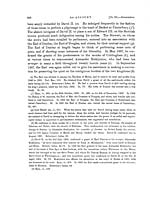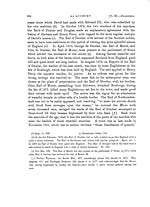Volume 3
(265) Page 253
Download files
Individual page:
Thumbnail gallery: Grid view | List view

253 In June 1368, the parliament of Scone advised the king to consult the Earls of Dunbar and Douglas, about the security of the eastern Marches (l). The Earl of Dunbar's experience was again looked up to by the nation, and the parliament appointed the Earl of Dunbar, with other respectable men, to watch over the general state of a harassed kingdom (m). This was probably the last public service which Patrick, the Earl of Dunbar, was required by parliament to perform for the common benefit. About this time he resigned his earldom and estates to his eldest son, George, who received a confirmatory charter from David II. on the 25th of July 1369 (n). (12.) George, the Earl of Dunbar, the first of this name, thus obtained the earldom of Dunbar, with the revenues and influence which belonged to that early jurisdiction at the epoch of the Stewartine period (a). By those vast and opulent acquirements, Earl George became one of the most powerful nobles of southern Scotland, the rival of the Douglasses, whom he surpassed in the antiquity and splendour of his descent. As this great baron lived till 1420, and received a sort of establishment as a young man in 1363, he must have been born a year or two after his mother's successful defence of their baronial castle in 1338, and he must of course have been twenty-nine or thirty when he became Earl of Dunbar in 1369. He soon came into action as a statesman. He first appeared as Earl of Dunbar and warden of the eastern marches on the 20th of July, when, with other nobles, he swore to maintain the fourteen (l) Parl. Rec., 113. (m) This was the Parliament of Perth, on the 6th of March, 1368-9. Id. (n) Robertson's Index, 85. That charter is said to have been granted in the thirty-ninth year of David II.; but it was really the fortieth, there being an error of one year short in many of the latter charters of that king, as the editors of that Index and others have remarked. David commenced his reign on the 7th of June, 1329, and demised on the 22nd of February, 1370-1, in the forty-second year of his reign. How long Earl Patrick lived after thus denuding himself of his title and estates, is not easy to discover. Douglas, the Peerage writer, has indeed fixed his mortal hour in 1360. He no doubt continued to enjoy the Earldom of Moray with all its revenues, in right of his wife, till the death of both. They probably were dead before the demise of David II, since they are not noticed at the coronation of Robert II. The fifth Patrick, Earl of Dunbar and March, as he was twenty-four in 1309, must have been eighty-four in 1369. (a) Besides the earldom, he acquired from his father's resignation the lands of Curanock in Ayr- shire, Blantyre in Lanarkshire, and Mochrum and Glenkens in Galloway. He had already obtained from his parent's resignation, on the 28th of June, 1363, the baronies of Morton and Tibbers in Nithsdale. Robertson's Index, 73. He also inherited from his heroic mother, the heiress of the great Randolph, the lordship of Annandale, the Isle of Man, the baronies of Mording- ton and Longformacus, with the manor of Duns, perhaps, in Berwickshire. Ib., 115, 122, 136, 144, 164.
Set display mode to:
![]() Universal Viewer |
Universal Viewer | ![]() Mirador |
Large image | Transcription
Mirador |
Large image | Transcription
Images and transcriptions on this page, including medium image downloads, may be used under the Creative Commons Attribution 4.0 International Licence unless otherwise stated. ![]()
| Caledonia, or, An account, historical and topographic of North Britain from the most ancient to the present times > Volume 3 > (265) Page 253 |
|---|
| Permanent URL | https://digital.nls.uk/74528604 |
|---|---|
| Description | Vol. III. |
|---|---|
| Attribution and copyright: |
|

